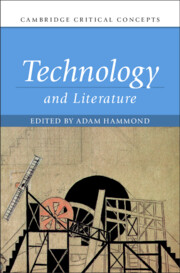Book contents
- Technology and Literature
- Cambridge Critical Concepts
- Technology and Literature
- Copyright page
- Contents
- Figures
- Contributors
- Timeline
- Introduction
- Part I Origins
- Chapter 1 Orality and Writing
- Chapter 2 Manuscript
- Chapter 3 The Hand Press, 1450–1800
- Chapter 4 The Mechanical Press, 1800–1900
- Chapter 5 The Typewriter
- Chapter 6 Literature in the Electric Age
- Chapter 7 Digital Text
- Part II Developments
- Part III Applications
- Index
Chapter 5 - The Typewriter
from Part I - Origins
Published online by Cambridge University Press: 30 November 2023
- Technology and Literature
- Cambridge Critical Concepts
- Technology and Literature
- Copyright page
- Contents
- Figures
- Contributors
- Timeline
- Introduction
- Part I Origins
- Chapter 1 Orality and Writing
- Chapter 2 Manuscript
- Chapter 3 The Hand Press, 1450–1800
- Chapter 4 The Mechanical Press, 1800–1900
- Chapter 5 The Typewriter
- Chapter 6 Literature in the Electric Age
- Chapter 7 Digital Text
- Part II Developments
- Part III Applications
- Index
Summary
This chapter shifts focus from large-scale changes in the manufacture and distribution of literature to the smaller-scale manner in which a mechanical device, the typewriter, changed how literary texts were composed. Spanning the period 1860–1980 – from the invention of the typewriter to its obsolescence – this chapter investigates how the typewriter affected who wrote, what they wrote, and how they wrote it. Wershler makes the case for the typewriter as an “assemblage”: a series of technologies, techniques, and discourses that work together to shape the expressive pathways in which humans express and constitute their subjectivities.
- Type
- Chapter
- Information
- Technology and Literature , pp. 107 - 124Publisher: Cambridge University PressPrint publication year: 2023

